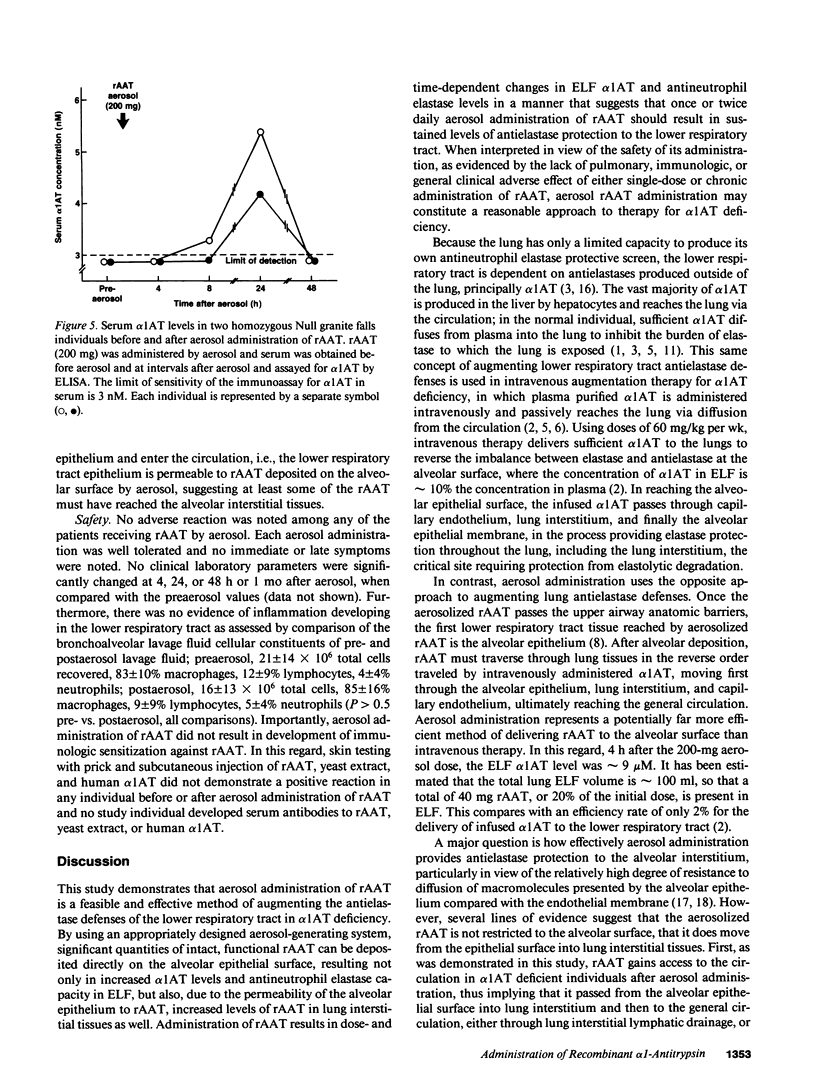Abstract
Alpha 1-Antitrypsin (alpha 1AT) deficiency is characterized by insufficient amounts of alpha 1AT to protect the lower respiratory tract from neutrophil elastase, resulting in emphysema. Yeast-produced recombinant alpha 1AT (rAAT) has normal antielastase function but is associated with high renal clearance, thus obviating chronic intravenous administration. As an alternative, we evaluated aerosol administration of rAAT to alpha 1AT-deficient individuals. After aerosol administration of single doses of 10-200 mg of rAAT, epithelial lining fluid (ELF) alpha 1AT antineutrophil elastase defenses were augmented in proportion to the dose of rAAT administered. ELF alpha 1AT levels and antineutrophil elastase capacity 4 h after 200 mg rAAT aerosol were increased 40-fold over preaerosol levels, and were fivefold increased over baseline at 24 h after aerosol administration. rAAT was detectable in serum after aerosol, indicating that the lower respiratory tract epithelium may be permeable to rAAT, and that aerosolized rAAT is capable of gaining access to lung interstitium. No adverse clinical effects were noted. These observations demonstrate that aerosol administration of rAAT is safe and results in significant augmentation of lung antineutrophil elastase defenses, suggesting this method is a feasible approach to therapy. Because this approach is clinically unproven, further studies will be necessary to establish the long-term clinical efficacy of aerosol therapy in alpha 1AT deficiency.
Full text
PDF





Images in this article
Selected References
These references are in PubMed. This may not be the complete list of references from this article.
- Casolaro M. A., Fells G., Wewers M., Pierce J. E., Ogushi F., Hubbard R., Sellers S., Forstrom J., Lyons D., Kawasaki G. Augmentation of lung antineutrophil elastase capacity with recombinant human alpha-1-antitrypsin. J Appl Physiol (1985) 1987 Nov;63(5):2015–2023. doi: 10.1152/jappl.1987.63.5.2015. [DOI] [PubMed] [Google Scholar]
- Crystal R. G., Brantly M. L., Hubbard R. C., Curiel D. T., States D. J., Holmes M. D. The alpha 1-antitrypsin gene and its mutations. Clinical consequences and strategies for therapy. Chest. 1989 Jan;95(1):196–208. doi: 10.1378/chest.95.1.196. [DOI] [PubMed] [Google Scholar]
- Fulmer J. D., Roberts W. C., von Gal E. R., Grystal R. G. Small airways in idiopathic pulmonary fibrosis. Comparison of morphologic and physiologic observations. J Clin Invest. 1977 Sep;60(3):595–610. doi: 10.1172/JCI108811. [DOI] [PMC free article] [PubMed] [Google Scholar]
- Gadek J. E., Fells G. A., Zimmerman R. L., Rennard S. I., Crystal R. G. Antielastases of the human alveolar structures. Implications for the protease-antiprotease theory of emphysema. J Clin Invest. 1981 Oct;68(4):889–898. doi: 10.1172/JCI110344. [DOI] [PMC free article] [PubMed] [Google Scholar]
- Gorin A. B., Stewart P. A. Differential permeability of endothelial and epithelial barriers to albumin flux. J Appl Physiol Respir Environ Exerc Physiol. 1979 Dec;47(6):1315–1324. doi: 10.1152/jappl.1979.47.6.1315. [DOI] [PubMed] [Google Scholar]
- Hubbard R. C., Brantly M. L., Sellers S. E., Mitchell M. E., Crystal R. G. Anti-neutrophil-elastase defenses of the lower respiratory tract in alpha 1-antitrypsin deficiency directly augmented with an aerosol of alpha 1-antitrypsin. Ann Intern Med. 1989 Aug 1;111(3):206–212. doi: 10.7326/0003-4819-111-3-206. [DOI] [PubMed] [Google Scholar]
- Hubbard R. C., Casolaro M. A., Mitchell M., Sellers S. E., Arabia F., Matthay M. A., Crystal R. G. Fate of aerosolized recombinant DNA-produced alpha 1-antitrypsin: use of the epithelial surface of the lower respiratory tract to administer proteins of therapeutic importance. Proc Natl Acad Sci U S A. 1989 Jan;86(2):680–684. doi: 10.1073/pnas.86.2.680. [DOI] [PMC free article] [PubMed] [Google Scholar]
- Hubbard R. C., Crystal R. G. Alpha-1-antitrypsin augmentation therapy for alpha-1-antitrypsin deficiency. Am J Med. 1988 Jun 24;84(6A):52–62. doi: 10.1016/0002-9343(88)90159-3. [DOI] [PubMed] [Google Scholar]
- Hubbard R. C., Crystal R. G. Alpha-1-antitrypsin augmentation therapy for alpha-1-antitrypsin deficiency. Am J Med. 1988 Jun 24;84(6A):52–62. doi: 10.1016/0002-9343(88)90159-3. [DOI] [PubMed] [Google Scholar]
- Hubbard R. C., Sellers S., Czerski D., Stephens L., Crystal R. G. Biochemical efficacy and safety of monthly augmentation therapy for alpha 1-antitrypsin deficiency. JAMA. 1988 Sep 2;260(9):1259–1264. [PubMed] [Google Scholar]
- Janoff A. Elastases and emphysema. Current assessment of the protease-antiprotease hypothesis. Am Rev Respir Dis. 1985 Aug;132(2):417–433. doi: 10.1164/arrd.1985.132.2.417. [DOI] [PubMed] [Google Scholar]
- Matthay M. A., Berthiaume Y., Staub N. C. Long-term clearance of liquid and protein from the lungs of unanesthetized sheep. J Appl Physiol (1985) 1985 Sep;59(3):928–934. doi: 10.1152/jappl.1985.59.3.928. [DOI] [PubMed] [Google Scholar]
- Nukiwa T., Takahashi H., Brantly M., Courtney M., Crystal R. G. alpha 1-Antitrypsin nullGranite Falls, a nonexpressing alpha 1-antitrypsin gene associated with a frameshift to stop mutation in a coding exon. J Biol Chem. 1987 Sep 5;262(25):11999–12004. [PubMed] [Google Scholar]
- Ogushi F., Hubbard R. C., Fells G. A., Casolaro M. A., Curiel D. T., Brantly M. L., Crystal R. G. Evaluation of the S-type of alpha-1-antitrypsin as an in vivo and in vitro inhibitor of neutrophil elastase. Am Rev Respir Dis. 1988 Feb;137(2):364–370. doi: 10.1164/ajrccm/137.2.364. [DOI] [PubMed] [Google Scholar]
- Rennard S. I., Basset G., Lecossier D., O'Donnell K. M., Pinkston P., Martin P. G., Crystal R. G. Estimation of volume of epithelial lining fluid recovered by lavage using urea as marker of dilution. J Appl Physiol (1985) 1986 Feb;60(2):532–538. doi: 10.1152/jappl.1986.60.2.532. [DOI] [PubMed] [Google Scholar]
- Smith R. M., Spragg R. G. Production and administration to dogs of aerosols of alpha-1-proteinase inhibitor. Am J Med. 1988 Jun 24;84(6A):48–51. doi: 10.1016/0002-9343(88)90158-1. [DOI] [PubMed] [Google Scholar]
- Travis J., Owen M., George P., Carrell R., Rosenberg S., Hallewell R. A., Barr P. J. Isolation and properties of recombinant DNA produced variants of human alpha 1-proteinase inhibitor. J Biol Chem. 1985 Apr 10;260(7):4384–4389. [PubMed] [Google Scholar]
- Wewers M. D., Casolaro M. A., Crystal R. G. Comparison of alpha-1-antitrypsin levels and antineutrophil elastase capacity of blood and lung in a patient with the alpha-1-antitrypsin phenotype null-null before and during alpha-1-antitrypsin augmentation therapy. Am Rev Respir Dis. 1987 Mar;135(3):539–543. doi: 10.1164/arrd.1987.135.3.539. [DOI] [PubMed] [Google Scholar]
- Wewers M. D., Casolaro M. A., Sellers S. E., Swayze S. C., McPhaul K. M., Wittes J. T., Crystal R. G. Replacement therapy for alpha 1-antitrypsin deficiency associated with emphysema. N Engl J Med. 1987 Apr 23;316(17):1055–1062. doi: 10.1056/NEJM198704233161704. [DOI] [PubMed] [Google Scholar]




